Статьи журнала - Журнал стресс-физиологии и биохимии
Все статьи: 1004
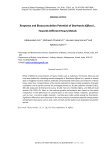
Response and bioaccumulation potential of Boerhavia diffusa L. towards different heavy metals
Статья научная
Effect of different concentrations of heavy metals such as Cadmium, Chromium, Mercury and Lead was studied by cultivating rooted propagules of Boerhavia diffusa for a period of twenty days in Hoagland nutrient medium artificially contaminated with known concentration of those heavy metal ions. Concentrations of the metals selected to impart visible symptoms of growth retardation and to permit survival for prolonged period are 30 µM cadmium chloride (CdCl 2), 400 µM potassium dichromate (K 2Cr 2O 7), 10 µM mercuric chloride (HgCl 2), and 600 µM lead acetate (CH 3-COO) 2 Pb. More or less uniform growth performance was shown by the plants irrespective of the differences of concentration of the heavy metals. However, parameters such as root - and stem length, stomatal - and tolerance index varied among the treatments. Significant differences were observed in the heavy metal accumulation potential among metals and between plant parts such as root, stem and leaf and the pattern was dependent on growth period.
Бесплатно
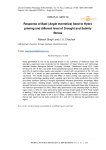
Статья научная
Seed germination is one of the essential factors in the cultivation of medicinal trees. The laboratory experiment was conducted at the Department of Seed Science and Technology, Hemwati Nandan Bahuguna Garhwal University, Srinagar, Uttarakhand during 2015. Hydro priming with 24 h & 48 h, and water stress (polyethylene glycol (6000) with potential 10%, 15% and 20%) & salinity stress (seeds were soaked in solution with concentration of 5% 10% and 15% NaCl for 3 hours) on seed germination and seedling quality character of bael ( Aegle marmelos ). The results showed that the effect of hydro priming was significant on seed germination percentage; seedling length, seedling vigour and dry matter production than control and stress condition (salinity & drought) significantly decrease germination percentage, Mean daily germination, seedling length, seedling weights & vigour indexes. Mean comparison showed that control and Hydro priming and stress conditions treatments those after 25 days and the maximum germination (91.56%), Mean daily germination (3.66), seedling length (15.84cm), vigour index 1 (1450.41), were achieved by hydro priming of bael seeds for 48 h, Fresh weight of seedling (1.62g), dry matter production (0.33g), and vigour index 2 (27.79). were achieved by hydro priming of bael seeds for 24 h, but in stress, conditions failed to improve germination. Hence bael seeds can be hydro primed for 48 h and 24 h to improve the germination and vigour.
Бесплатно
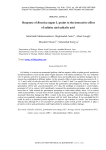
Response of Brassica napus L grains to the interactive effect of salinity and salicylic acid
Статья научная
Soil salinity is a serious environmental problem that has negative effect on plant growth, production and photosynthesis. Fresh and dry plant weights decreases with salinity treatments. The very important role of salicylic acid (SA) in response to different stress and modification and decline damages due to stresses has established in different studies. In this research, effect of grain soaking presowing in (0, 1, 1.5, 2 and 5 mM) of salicylic acid (SA) and NaCl (0, 4, 8 and 12 dsm-1) on canola (Brassica napus L) was studied. Increasing of NaCl level reduced the germination percentage(GP), Average velocity of germination (AVG) and growth parameters of 15-day old seedlings in compared to control plants. pretreated of SA in content 1mM significantly increased the germination percentage, and in contents more than of 1mM reduced the germination percentage in seeds under salinity stress. SA in content 1mM increased RWC, root and shoot of fresh weight in the stressed seedlings. Increasing of NaCl level increased Electrolyte leakage and MDA content in the stress seedling. electrolyte leakage and MDA content were markedly reduced under salt stress with SA 1mM than without. It was concluded that SA could be used as a potential growth regulator to improve salt tolerance in canola. Our observations indicate that, although SA is not essential for germination under normal growth conditions, it plays a promotive role in seed germination under high salinity by reducing oxidative damage.
Бесплатно
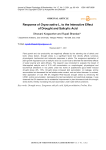
Response of Oryza sativa L. to the Interactive Effect of Drought and Salicylic Acid
Статья научная
Plant growth and rice productivity are negatively affected by the alarming rise of abiotic and biotic stress factors. Drought stress is a significant factor that directly affects numerous physiological, biochemical and molecular responses in plants. The exogenous application of plant growth regulators such as salicylic acid is a crucial route to alleviate the detrimental effects of water scarcity and plant efficacy. The research was conducted to evaluate the impact of foliar-applied salicylic acid of 0.25 mM concentration on morphological, physiological and biochemical alterations in rice plants under two levels of polyethylene glycol 6000 induced drought stress (8%, 16%). Drought stress increased lipid peroxidation, ion leakage, proline accumulation but decreased the leaf relative water content, root and shoot biomass. In contrast, foliar application of 0.25 mM SA mitigated PEG-induced drought stress by enhancing the LRWC, proline accumulation, decreasing the lipid peroxidation and electrolyte leakage. It was observed that SA treatment led to substantial improvement in plant biomass at both the drought stress levels, thereby increasing the plant acclimation under water deficit conditions.
Бесплатно
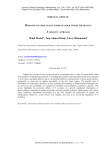
Response of crop plants under sulphur stress tolerance: a holistic approach
Статья научная
Sulphur (S) is a part of every living cell and is a constituent of two of the 20 amino acids which form proteins. Of all the macronutrient, S is perhaps the nutrient which has attracted the most attention in soil science and plant nutrition due to its potential defensive characteristics to pests, good nutritive potentiality to crops and its relative immobility in the soil- plant system. The benefits from S fertilisation of crops can be traced to its role in protein development, to improvement of nitrogen use, etc. However, the availability of S needed for profitable crop production continues to decline. This review highlights the prominent effects of S in plants (i.e. growth retardation, alternations of photosynthesis, stomatal movement, enzymatic activities, protein synthesis, interferences with various stress conditions, membrane functioning etc.) but also includes the mechanism of uptake and translocation. Moreover, it also throws new insights, have led us to revisit the hypothesis of S chelation.
Бесплатно
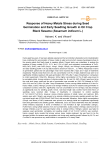
Статья научная
During past few years, it has been globally experienced that uncontrolled urbanization and industrialization have contributed the accumulation of heavy metals in water and soil which causes physiological stress to the growing plants that finally leads to negative effects. Present study was undertaken to analyze the response of heavy metals (0.01%, 0.1%, and 1.0%) of HgCl2 and equivalent concentrations of CoCl2, NiCl2,CdCl2, ZnSO4, and CuSO4 (5mg/L, 10mg/L, 25mg/L, 50mg/L, and 100mg/L) during seed germination and early seedling growth in oil crop black sesame ( Sesamum indicum L., cv. TMV3). Responses in terms of germination (partial and full) percentage mean were recorded after 3-days and 7-days of treatments respectively. Results reveal that even very low concentration (0.01%) of HgCl2 treatment was seen to be significantly inhibitory leading to full seed germination (60±1.0%) after 7-days of treatments in comparison to control experiment (100±0.5%). Moreover, further higher concentration (0.1%) of HgCl2 was proved to be completely lethal. Among solutions of chloride metals (Co, Ni, and Cd), NiCl2 (25mg/L) was found to be the most toxic heavy metal and the rate of germination was recorded as (10±1.0%) followed by CdCl2 (40±1.0%) and CoCl2 (50±1.0%) after 7-days of treatments. Further, among sulfate solutions of Zn and Cu- heavy metals, CuSO4 (100mg/L) proves to be strongly inhibitory (0±0.0%) for sesame seed germination in comparison to ZnSO4 (30±0.5%). Significantly, very low concentration (0.01%) of HgCl2 was also emerged as significantly toxic for seedling growth, hence, root-shoot length ratio (0.38±0.14cm/0.44±0.16cm) of seedlings were recorded after 10-days of treatments in comparison to control seedling (2.11±1.04cm/3.77±0.19cm). However, among chloride solutions of cobalt, nickel, and cadmium, NiCl2 solution even with (10mg/L) was proved to be strongly inhibitory during early seedling growth and thus, root-shoot length ratio (0.03±0.02cm/0.33±0.22cm) was recorded. Moreover, further higher concentrations (25mg/L and above) of NiCl2 treatments were proved to be strongly lethal and suppressed significantly both seed germination and seedling growth. Additionally, CoCl2 and CdCl2 treatments were also exhibited similar inhibitory responses in terms of inhibitions in root formation at high concentration (25mg/L). Furthermore, during sulfate solutions of Zn and Cu-treatments, CuSO4 solution (100mg/L) was found to be strongly inhibitory even for seed germination while in contrast ZnSO4 (100mg/L) solution was failed to suppress seed germination completely and seedling length (0.1±0.11cm/0.11±0.6cm) was recorded. Hence, present study reveals that among various heavy metals employed, Hg was found to be the strongest inhibitor for sesame seed germination and during early seedling growth followed by Ni, Cd, and Co while Zn was proved as very weak inhibitor in comparison to Cu heavy metal.
Бесплатно
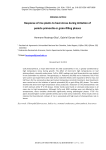
Статья научная
Leaf photosynthesis, a major determinant for yield sustainability in rice, is greatly conditioned by high temperature stress during growth. The effect of short-term high temperatures on leaf photosynthesis, stomatal conductance, Fv/Fm, SPAD readings and yield characteristics was studied in two Colombian rice cultivars. Two genotypes, cv. Fedearroz 50 (F50) and cv. Fedearroz 733 (F733) were used in pot experiments with heat stress treatment (Plants were exposed to 40°C for two and half hours for five consecutive days) and natural temperature (control) treatment. Heat treatments were carried out at the initiation of panicle primordial (IP) or grain-filling (GF) phases. The results showed that short-term high temperature stress produced a reduction on the photosynthesis rate in both cultivars either IP or GF phases. Similar trends were found on stomatal conductance in all cases due to high temperatures. Although Fv/Fm and SPAD readings were not affected by high temperatures, these variables diminished significantly among phenological phases. 'F733' rice plants showed higher number spikelet sterility due to heat stress treatments. These results seem to indicate that heat-tolerant cultivars of rice is associated with high levels of photosynthesis rate in leaves.
Бесплатно
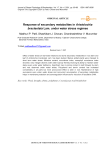
Response of secondary metabolites in Aristolochia bracteolata Lam. under water stress regimes
Статья научная
Effect of water stress on leaf water relations and some secondary metabolites in root stem and leaf of Aristolochia bracteolata Lam. has been studied. Mature potted plants were imposed to short term water stress. Moisture content, succulence index, mesophyll succulence index showed a very meager decline under water scarcity thereby showing its ability to maintain water status even under water deficiency. Significant rise in proline content in leaf followed by stem and root observed under water stress. Polyphenol and tannin content has increased considerably in all parts but more pronounced effect is seen in root. Maintenance of high succulence even under water stress and concurrent accumulation of secondary metabolites helps in membrane protection and osmoregulation influences for induction of facultative CAM.
Бесплатно
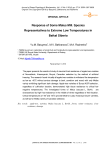
Response of some Malus mill. species representatives to extreme low temperatures in Baikal Siberia
Статья научная
The paper presents the results of study of maximal frost resistance of apple-tree varieties of Novosibirsk, Krasnoyarsk, Buryat, Canadian selection by the method of artificial freezing. The research found virtually all apple-tree varieties to withstand the temperature as low as -45оС without serious damage to bark, cambium and wood; with only Melba variety exhibiting significant bark damage. Apple-tree varieties of Buryat ACRI selection, regardless of cultivation location, demonstrated high tissue resistance to critical low negative temperatures. The investigated forms of Malus baccata L. Borkh, are characterized by high frost resistance in the middle of winter regardless of their location. Critical temperatures of -50о and -55оС proved lethal for Lada, Krasnaya Grozd’ varieties, as well as for Melba variety of Canadian selection.
Бесплатно
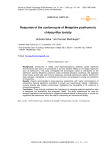
Response of the coelomocyte of metaphire posthuma to chlorpyrifos toxicity
Статья научная
Background: Chlorpyrifos, a widely used organophosphorus pesticide, poses significant environmental risks due to its persistence in soil and adverse effects on non-target organisms such as earthworms. This study investigates the toxicological impact of chlorpyrifos on the earthworm species Metaphire posthuma under controlled laboratory conditions. We assessed acute toxicity, growth rate, and immune responses, including coelomocyte viability. Earthworms were collected, maintained in a controlled environment, and exposed to varying concentrations of chlorpyrifos.
Бесплатно
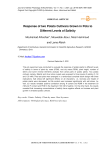
Response of two Potato Cultivars Grown in Pots to Different Levels of Salinity
Статья научная
This pot experiment was conducted to evaluate the response of potato plants to different levels of salinity in terms of plant dry mass (PDM), root dry mass (RDM), plant height, number of stems and some mineral elements analysis from aerial parts of potato plants. Two potato cultivars namely, Madrid and Alver stone russet were exposed to three levels of salinity (0, 50 and 100 mM). Pots test plots were arranged in a randomized complete block design with three replications. Salt stress left significant effects on all characters, i.e., biomass and height of potato plants were decreased, but Na content was increased significantly with salt stress. As well, our results revealed positive correlation among K content and RDM in the treatment 50 mM and P content and PDM in the treatment 100 mM of salinity. On the other hand, the results revealed that increasing concentrations of salinity have negative effects on biomass and plant growth in all tested potato cultivars.
Бесплатно
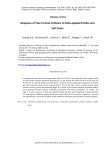
Response of two tomato cultivars to field-applied proline and salt stress
Статья научная
An experiment was carried out using saline water (6.57 dS.m -1) and subsurface drip irrigation (SDI) on two tomato cultivars ( Solanum lycopersicum, cv. Rio Grande and Heinz-2274) in a silty clay soil. The former is a salinity tolerant and the latter a sensitive cultivar. Exogenous application of proline was done by foliar spray at two concentrations: 10 and 20 mg.L -1, with a control (saline water without proline), during the flowering stage. As a result of the proline applied, significant effects were observed on both cultivars of tomato, particularly with low concentration of proline (10 mg.L -1). It led to increase of leaf area, growth length and fruit yield. Regarding mineral nutrition, Ca 2+ was higher in different organs while low accumulation of Na + occurred. However, Cl - was very low significantly in all tissues of plants of Rio Grande at the higher concentration of proline applied.
Бесплатно
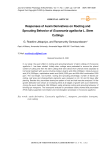
Статья научная
In our study, the auxin effect on rooting and sprouting behavior of stem cuttings of Excoecaria agallocha L. has been studied. Initially stem cuttings were pretreated to remove the phenol content of cutting and then the stem cuttings that were devoid from phenols were subjected to hormonal treatment with auxins including indole-3-butyric acid (IBA) 2000ppm, indole-3-pyruvic acid (IPA) 2000ppm, naphthalene acetic acid (NAA) 2000 ppm and IBA+NAA combination 2000 ppm. The root length, root number, rooting and sprouting percentage, number of leaves per cutting, leaf area and photosynthetic pigments were analyzed on 40, 50 and 60 days after planting. Besides this, peroxidase isoenzyme pattern of root and leaf was also analyzed. All the growth attributes have shown an increasing trend at all stages of growth with auxin treatments. Among the auxin treatments, IBA 2000ppm vastly enhances rooting and sprouting behaviour of blinding eye mangrove. The isoenzyme analysis for peroxidase clearly showed that peroxidase (POX) highly supported root initiation and root elongation processes in Excoecaria agallocha.
Бесплатно
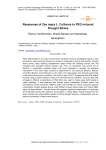
Responses of Zea mays L. cultivars to peg induced drought stress
Статья научная
Water deficit stress is one major environmental constraint having a devastating impact on crop productivity. Improving plant tolerance to drought is imperative to ensure food security. Drought stress during maize seedling establishment stage lowers the seedling survival rate and increases post pollination embryo abortion rate. Thus, an experiment was carried out as factorial in randomized complete design with three replicates to evaluate the tolerance mechanism of five local maize cultivars at Department of Life Sciences (Botany), Manipur University, Manipur during February to April, 2022. The maize seeds were allowed to germinate under control environment conditions: 14h light/10h dark, 25±2oC temperature and 60% relative humidity using a growth chamber (Tanco PLT-149 Plant Growth Chamber). At seven days after emergence, different concentrations of PEG-6000 were used to impose water deficit stress to maize seedlings. It was observed that drought stress substantially inhibited growth and development across all cultivars. Relative water content (RWC) as well as chlorophyll pigment concentration showed gradual decline under different drought stress levels with cultivar M002 being the least affected. Drought stress also triggered significant augmentation of osmolytes and antioxidant activity with maximum accumulation in cultivar M002. Overall findings from this study indicate that cultivar M002 possess promising drought tolerance characteristics and can perform successfully in water scarce regions.
Бесплатно
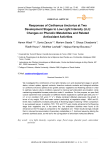
Статья научная
We investigated the contributions of low light intensity (LLI) and development stage on growth status, nutrient uptake, pigment contents, bioactive molecule contents and biological activities on carthamus tinctorius plants at two growth periods: vegetative and flowering periods in order to optimize natural culture conditions required to improve leaf antioxidant accumulation; while maintaining acceptable biomass production under LL conditions. For this purpose, an open field culture experiment was conducted on safflower leaves subjected to optimal light (250 µmol m-2 s-1) or LLI condition (125 µmol m-2 s-1). Shade constraint affected extensively the growth in terms of dry weight, RGR and water content particularly at vegetative stage. MDA and EL levels had a noteworthy increase particularly at flowering stage S reaching +34%in comparison to sun-exposed leaves. In addition TPC, TFC and TCT were mostly enhanced at full flowering stage than vegetative one. In the same line, the antioxidant activities were found to be enhanced at the FS stage as compared to the vegetative one. These results strongly indicate that LL induces the accumulation of secondary metabolites in C. tinctorius leaves by altering the phenolic synthesis pools, as well as for the up-regulation of antioxidant molecules defense
Бесплатно
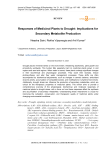
Responses of medicinal plants to drought: implications for secondary metabolite production
Статья обзорная
Drought places immense stress on the environment, threatening biodiversity, plant growth and productivity worldwide. This burden falls especially hard on medicinal plants grown in arid regions and semi-arid regions. When water is scarce, these plants undergo significant changes in their biochemical and physiological processes. They close their stomata, reduce photosynthesis, and alter their water management processes. These shifts are often accompanied by biochemical adjustments, such as changes in osmotic balance, antioxidant enzyme activity, accumulation of compatible solutes, and modifications in phytohormone levels. Additionally, drought stress can influence the production of secondary metabolites, which are critical for the therapeutic properties of medicinal plants. This review aims to provide a comprehensive overview of the physiological, biochemical, and molecular responses of medicinal plants to drought stress, with a focus on how these responses affect the synthesis and accumulation of secondary metabolites. Understanding these mechanisms is crucial for improving the cultivation, conservation, and therapeutic quality of medicinal plants under changing environmental conditions.
Бесплатно
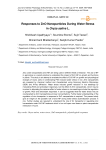
Responses to ZnO nanoparticles during water stress in Oryza sativa L
Статья научная
Zinc oxide nanoparticles (ZnO NP) are being used in different fields of research. The use of NP in agriculture is a recent practice to understand the impact of ZnO NP on growth and functions in plants. This study is an attempt to evaluate the effect of ZnO NP on growth and physiological changes of Oryza sativa in ameliorating PEG induced water stress in rice. ZnO nanoparticles are prepared by chemical method and characterized using Scanning Electron Microscopy (SEM) and X-Ray diffraction. Water stress induced growth reduction in rice seedlings by modulating ROS and antioxidant responses, but the effect of ZnO nanoparticles, which may be involved in alleviating the adverse effect of water stress on rice seedlings include the regulation of growth, ROS and antioxidant responses. It can be suggested that the water stress may be counteracted by ZnO nanoparticles at lower concentrations. Further detail understanding of the regulation of zinc transporter in response to ZnO nanoparticles is required. The present study give an insight on the possible role of ZnO NP during water stress acclimatization process in rice. Further studies are required to understand the role of Zn transporter in regulating zinc homeostasis under ZnO NP treatment which in turn will open new ideas on plant-nanoparticles interaction in future.
Бесплатно
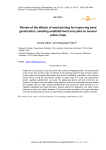
Статья обзорная
Pulses are a unique type of crop due to their high content of vegetable protein, an important part of the human diet, and their major contribution to the cropping system through nitrogen fixation. A wide range of physiological deterioration that results in qualitative, quantitative, and economic losses occurs during the post-harvest storage of pulse crops. For pulse crop germination, growth, seedling establishment, and yield, the appropriate abiotic and biotic conditions are required. The article covers the seed priming approach, which can coordinate seed germination and increase vigor for better seedling establishment and productivity. Seed priming turns on metabolic pathways that break dormancy, prevent seeds from degrading, and boost overall resilience to biotic and abiotic stressors. The overall review provided in this paper describes how seed priming enhances pulse crop germination, seedling establishment, growth, and yield.
Бесплатно
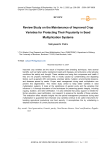
Статья обзорная
Improved crop varieties are the result of important plant breeding techniques, have several benefits, such as higher yields, resistance to pests and diseases, and endurance under adverse conditions like salinity and drought. These varieties are losing their uniqueness and health if they are not properly maintained. This is mostly caused by contaminating and degrading factors, such as genetic drift, outcrossing, volunteer plants, mutation, environmental stressors, and diseases spread by seeds. Proper seed management during seed multiplication can prevent this degeneration. This review study aimed to keep better varieties in seed multiplication systems. It looks at the significance of genetic purity and the variables that influence it. A thorough discussion of the techniques for preserving genetic integrity, including roguing, isolation, and seed certification. It is also stressed that policy support is needed for farmer education, seed certification, and research to preserve the benefits of these varieties. This evaluation offers valuable insights into the optimal management procedures during seed multiplication to guarantee that enhanced crop varieties continue to be useful instruments for boosting agricultural productivity and food security. It accomplishes this by undertaking a detailed examination of current practices and advances.
Бесплатно
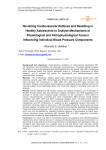
Статья научная
Background and objectives: Understanding oscillations of cardiovascular parameters (BP, HR, blood flow, heart contractility, etc.) has been a puzzling issue. This paper intends to assess the effects of various physiological and pathological factors like gender, age, BMI, handedness acute perceived stress and chronic perceived stress on individual components of blood pressure, and to evaluate and gauge the physiological and pathophysiological reflex mechanisms for the same. Methods: 120 normotensive, healthy adults were included with equal gender ratio. After obtaining consent, age, BMI, Handedness and STAI for perceived acute and chronic stress were recorded. BP components i.e. SBP, DBP, PP, MAP and RPP were recorded and calculated. Physical, psychological, physiological and pathological factors affecting cardiac and vascular systems were deliberated. Mean, SD, T-test and Pearson’s correlation were used for analysis. Results: Gender difference in BP showed cardiac and vascular protective role of oestrogen in females through eNOS. Age had significant negative correlation with RPP suggesting early changes in cardiac mass reducing oxygen extraction by the myocardium, while based on various neuroendocrinal, hormonal and renal mechanisms, BMI showed strong positive correlation with SBP, DBP and MAP, proposing changes within circulating blood volume, cardiac output and large vessels. Unlike previous studies, there was no correlation between handedness and BP components on subjects at rest, suggesting cerebral dominance on autonomic influences might be active only in BP stimulating situations. Acute perceived stress showed negative correlation with all BP components recommending extended biopsychosocial model and active baroreceptor reflex unlike acute physical stress, which shows elevated BP, which can only be obtained by resetting threshold response of baroreceptor to higher level. Chronic perceived stress correlated with elevated SBP and MAP suggesting rumination, cardiovascular remodelling, reflex adaptation and resetting. Conclusion: Our study has tried to hypothesise specific physiological and pathophysiological mechanisms which might be involved in changes of individual blood pressure components. It is fascinating to notice that none of the observed factors (physiological and pathological) has any correlation with Heart Rate. Our subjects were at rest and hence, heart rate was normal, showing no variations. This article helps to understand probable underlying mechanisms for the same.
Бесплатно

